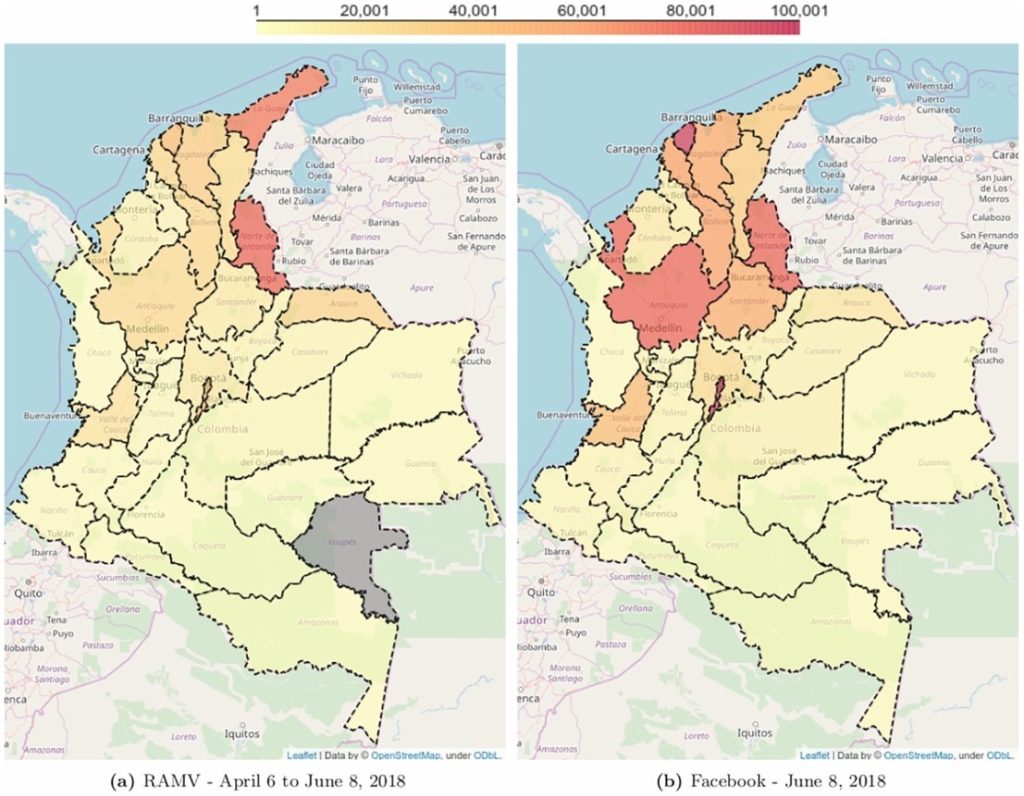The Venezuelan displacement crisis is now four years old.
As of February 2020, it is estimated that 4.8 million Venezuelans have left their country. The vast majority of them have left their country in an attempt to escape the negative fallout (e.g. food shortages; unemployment; violence) triggered by ongoing political and economic instability. According to UNHCR-IOM estimates, if this trend continues, 6.5 million Venezuelans could be living outside Venezuela by the end of this year.
Since the crisis started, there has been a rising tide of initiatives that encourage the use of new technologies to improve the lives of Venezuelan migrants and refugees. But heavy caution should be taken: as suggested by Lindskov Jacobsen, humanitarian efforts face challenges that new technologies cannot always solve, and their introduction may even create new challenges that lead to even further harm.
To offer insight into best practices, this article takes a look at three different approaches:
- Using Facebook’s advertising platform to monitor exodus
Neighbouring host countries in Latin America have tried to measure the number of displaced Venezuelans in their lands. Accurate measures and spatial distributions of migrants and refugees are paramount as they enable the adequate and efficient design and implementation of humanitarian responses. In other words: data is essential. However, traditional measurement methods are not precise and present various limitations. For example, the government of Colombia implemented RAMV (for its acronym in Spanish), a process which sought to expand the information on Venezuelan migrants in Colombia. This initiative, piloted from April to June 2018, gave Venezuelans living in Colombia the option to self-identify themselves at numerous registration points.
Nonetheless, this approach had three main shortcomings. First, it only gives us a snapshot of the situation, and not the full story. Second, the economic costs associated with setting up 1000 registrations points were high. And third, it relies on voluntary and self-reported data, which is likely to lead to incomplete data.
In response to these limitations, Palotti et al. used data from Facebook’s advertising platform to monitor migration more precisely, given that approximately 70% of the Venezuelans have a Facebook account. Compared to R4V data, their results exhibit similar patterns and spatial distributions, but Facebook’s API showed more Venezuelan migrants and refugees in several departments (or states). The largest difference was observed in Bogotá, where Facebook calculated 490k Venezuelan refugees and migrants, while the RAMV reported only 43k (See figure 1).
Figure 1

Estimates of Venezuelan refugees and migrants in Colombia; Source: (Palotti et al.). (a) estimates from RAMV and (b) estimates from Facebook.
Additionally, the authors used Facebook’s API to provide data on the socioeconomic status of migrants and refugees, in order to compare it with the host population’s characteristics. This may help predict possible resentment within host communities before it unfolds. Their results show that Panama and Costa Rica have received wealthier and educated Venezuelans, while Colombia and Peru have received poorer and less educated Venezuelans.
- BetterTogether Challenge
The BetterTogether (JuntosEsMejor, in Spanish) challenge was launched in October 2019 by the Inter-American Development Bank (IADB) in partnership with the United States Agency for International Development (USAID). This initiative seeks to identify, finance, and scale up innovative solutions that aim to improve the lives of newly arrived Venezuelans in various host communities throughout Latin America and the Caribbean. In its annual programme statement, USAID and IADB briefly mention the risks that both beneficiaries and bidders may exhibit overall, yet omit the risks associated with the introduction of new technologies, which often carry negative side effects even amidst “good” intentions, as mentioned earlier.
- An opening for digital money
Cash assistance can foster an anti-displacement attitude within host communities. However, humanitarian aid can be recalibrated to benefit both Venezuelans and host countries by using vouchers and digital money, therein allowing Venezuelan migrants and refugees to purchase their choice of goods from licensed local shops. (One such case study: the World Food Programme’s ‘Bamba Chakula’ in Ethiopia and Kenya.) Moreover, vouchers could be transferred digitally using blockchain to minimise the administrative costs associated with these payments. CaLP estimates that, in India, automated digital government payment flows could potentially save up to $22.4 billion USD per year, which is approximately 8% of total flows.
***
The use of new technologies can benefit refugees and migrants in a number of ways. However, there are serious potential drawbacks. The use of blockchain could allow governments, corporations, and international agencies to track people’s choices and increase surveillance over refugees. Similarly, Facebook’s marketing framework could be used against Venezuelans fleeing their country. Both Venezuela and other host governments could use these aforementioned approaches to restrict free movement. Corporations could take advantage of vulnerable Venezuelan migrants and refugees by using data on socio-economic statuses.
These examples should act as warnings for technologists and initiatives, such as the BetterTogether challenge, and encourage them to reflect when designing or implementing new programmes and applications. By doing so, a series of trade-offs that boost positive effects and minimise negative effects may be achieved in order to aid those in this vulnerable crisis.
About the author: Agnes Medinaceli Baldivieso is a MSc in Migration Studies candidate.
